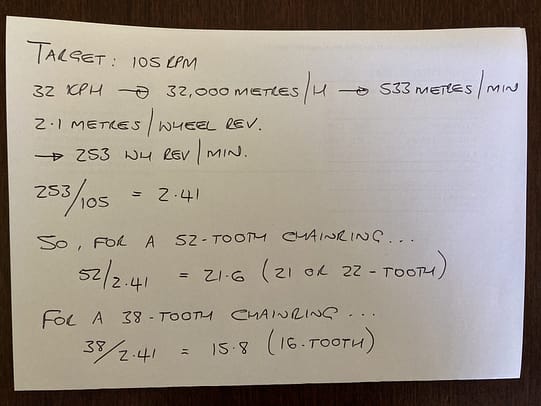Introduction
The singlespeed cadence workout stems from my time racing iron-distance triathlon.
It's common to hear triathletes say that they are "genetically low cadence" bike riders and then to employ all kinds of mental gymnastics to justify why this is better than riding at a high cadence.
In fact, they're not genetically limited at all, they're neuromuscularly limited.
The ability to pedal at a high cadence is a neuromuscular skill. Simply put, your brain needs to practise executing that pattern that quickly. If you don't train it, you'll never have it.
How do I know this? Simply because I was one of those 70RPM guys, yet I can now ride seemingly all day at a cadence of 105RPM. I developed this singlespeed cadence workout as part of the solution and have used it successfully with a range of clients too.
The version I developed used a dedicated singlespeed bike, but you can do the same on a geared bike, you simply need the discipline not to change gear when the going gets tough: and it will.
[I followed the steps below in the photo of my rough calculation.]
Step one is to decide what cadence you're going to target.
Once you know that, you work backwards to decide on the size of gear you're going to use, based on the speed you know you should be able to hold. When you can do that, you increase the size of the gear and start again.
- Decide how fast you want to ride based on what your usual average would be.
- Calculate how far you need to travel per minute to attain that speed.
- Measure how far your bike will go with one revolution of the wheel.
- Calculate how many wheel revolutions you need per minute to attain this speed.
- You now know your required gear ratio. This is how many times the wheel should turn for every revolution of the pedals.
- Divide the number of teeth on your front chain ring(s) by this ratio to give you the size of rear sprocket you need to attain that ratio.
Once you've done this calculation, all you need to do is set your bike up in this gear and ride at your desired cadence. If you hold that average cadence throughout the singlespeed workout, you'll ride at the average speed you decided upon. Or conversely, if you ride at that average speed, you'll attain that average cadence. These two measures will give you all the feedback you need.
In terms of the ride, you need flat or gently rolling terrain because you need to be able to realistically maintain your cadence for the duration of the workout.
The singlespeed cadence workout is challenging. Because of the neural demands of pedalling faster than you're used to, you'll probably be very tired afterwards (brain and body). This is normal, so make sure to give yourself plenty of recovery time afterwards.
How to do it...
Do the calculation above and make sure you have the appropriate gearing on your bike.
Warm up by riding at an easy pace for 10 to 15 minutes.
If you're riding a geared bike, change to your target gear and leave the gears alone for the entire workout no matter how hard it gets.
Ride on a flat or gently rolling course for between 90 minutes and 2 hours at your desired average speed and cadence.
Cool down by riding 5 minutes at an easy pace.


